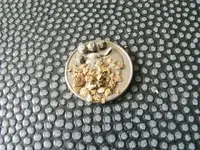Wow, no buckets either! Ok prospecting equipment that fits their demands.
I assume that there are some rocks along the sides of the creek/stream/river, between and under these rocks is where the gold will settle as well as in cracks in the bedrock, undercuts along the stream bank and under/behind anything that blocks the water from flowing down hill. A short lesson: A boulder sitting in a river, this could be VW Bug sized to 2' x 1' but a boulder in the way of water flow, at the front of the boulder there is a high water pressure zone and it carries all sorts of sediments including gold and causes all the material to pass over the boulder. BUT at the back side of the boulder there is a natural low pressure zone and the heaviest and some of the lighter material drop out here. So on the down river side of boulders are where one should look for gold or other heavy materials. How are these areas worked?
Is it ok to move rocks/boulders if so move them and collect the dirt that is under them and process it. Processing dirt: have a classifier, pour dirt into it, shake classifier with gold pan under it (this is dry classifying and assumes your dirt is also dry); have a classifier, pour dirt into it, hold classifier in water like in gold pan and shake classifier wetting all the dirt. Either dry or wet the fines will drop through the classifier into the pan and now they can be panned. Learn how to pan "heavy materials" out of dirt at home by using lead shot or BB gun BB's in dirt and when you practice getting all the lighter materials out of your pan and all the BB's or at least most of them are still in the pan then you have a pretty good panning method. If you expect to find gold all the BB's should still be in your pan so work at panning technique "at home".
So now you have a trowel, a classifier and a pan. Additionally for working around rocks and cracks and pockets you need a scraping tool, a piece of dry cloth and a cheap 1" paint brush. The scraping tool is nothing more than a 1/8" diameter steel rod with a point on one end and a "Beaver Tail" flattened end on the other end. The rod should have some length to it say 16" or long enough to work the particular spot you need to work. The beaver tail end should be bent at about a 90 degree angle so it can be used as a scraper. (note: make the point first when the rod is still straight) What you are doing with this tool is removing small rocks and dirt from a crack you've found in a rock, bedrock or between large rocks that you can not move. The setup for this type of work is as follows: spread the dry cloth/rag out as close as possible to the mouth of the crack you are working, use the scraper to remove the contents of the crack, use the brush to move the dirt onto the cloth. Once you have a nice pile of dirt carefully fold the rag over so the dirt is not lost and transfer the dirt into your pan. Once you have a good sized pile of dirt in the pan then pan it out. Note here that the gold is more than likely at the bottom of the crack but you should find signs of gold in the dirt as you get closer to the bottom of the crack. And these form the basic tools of prospecting along with a hat to keep the son off of you, lunch, water to drink, possibly a soft cushion to sit on while you work or rest (the cushion or foam pad is going to get dirty) and oh yes, a sample bottle (like a 35 mm film can or other plastic bottle) {glass bottles out in the filed break too easily and should be used for keeping samples in at home}. Oh and a simple magnifying glass is nice say about 10 power. Remember if a flake you've found is gold then when you press on it with a small knife blade it will fold NOT Break. Learn how to identify gold from other 'colored' objects.
So go find some gold..............63bkpkr





